zen
The Ten Ox Herding Pictures.
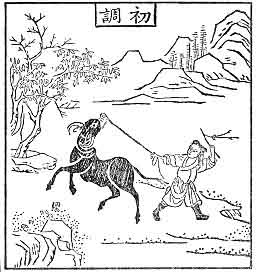
If you have an interest in Zen and the martial arts, you may or may not have come across the allegory of ‘The Ten Ox Herding Pictures’.
I have been meaning to post on this subject for a while now, and although I am not really a committed Zen Buddhist adherent by any significant measure, I have an outsider’s interest.
Before I get into it in any detail, let me say that I don’t see this allegory as uniquely ‘Zen’, I think it has a wider application, particularly for anyone exploring the conundrum of self-realisation and self-actualisation.
The ten images tell a story of a boy, the ox-herd, and his search for the missing ox and is a metaphor of the search for the true self (the original self); in Buddhist terms, the search for Awakening and the True Reality. The Ox-herd is the smaller self, the ego, who gradually realises that the reality is actually not far away and ultimately contained within him.
History.
Although these images developed a considerable following inside Japan, they are definitely Chinese in origin (as is Zen Buddhism actually). The earliest record of this sequence of images as a metaphor date back to the 11th or 12th century in China. There are usually accompanied by poems, but I would argue that you really don’t need them. At a visual level, you fill in the blanks with your imagination – no need for words – so very ‘Zen’.
The key differences between the various versions are usually found in the last three pictures. Some versions are content to just complete the series with a blank circle, (which particularly resonates with me), but, arguably, others have a deeper story to tell, making the final picture one of a Buddha or Boddhisatva in the ‘market place’, as if to say, ‘once enlightenment is complete, return to the world, to the busiest place and just ‘be’, amongst the people’. I like that – nobody disappears up into a mountain cave; that is not the place for the sage or the enlightened one. This is a philosophy that is nearer to the Neo-Confucianists, who I believe, have a closer resonance with the martial arts that we know. [1]
A description.
A boy is out in the countryside clearly looking for something. He is sometimes shown holding a kind of tether in his fist. (The wildness of the landscape increases as the narrative develops, as if to underline the difficulty of the quest).
At first he sees the ‘traces’ of the ox (which is sometimes referred to as a bull). Whether this is tracks, or even other things bulls and oxen tend to leave behind, is not really clear.
He catches a glimpse of the untamed ox. This wild spirit shows him a ‘Way’, it’s a hint, but it gives him direction and purpose. This is the beginning of ‘Do’ or ‘Tao’.
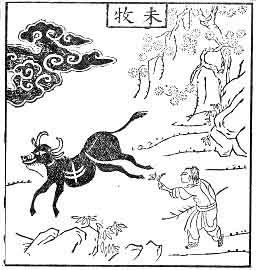
The boy pursues the ox, taking to his task with great determination. He finally connects with the animal and manages to attach the tether to it. The hard work begins. It’s a battle between the raw energy of the ox and the willpower and determination of the boy.
The boy is unaware that he is wrestling with his own true nature and trying to bridge the gulf between his uncultured petty ego and the untainted purity of his elemental self. The Buddhists enjoy the use of metaphor to describe this pure self; they are particularly fond of the image of a lotus flower that rises in its purity from the mud of the pond, perfect and unfouled. This is the true self that resides in all of us that remains pure and clean however much with sully it our own self-inflicted contaminants; which, with discipline, can shine forth again.
This is the discipline of the Dojo and the trials of the martial way; whether you want to describe it as a form of self-transformation (internal alchemy), or the ‘forging’ process of Tanren, it is a deep emersion in the greater process of training.
The disciplining of the ox in the various versions usually seems to take a couple of pictures, as if to accentuate the battles that occur between the boy and the ox. Gradually the creature succumbs to harness and becomes placid and resigned to the process. (In some versions the ox starts out pure black in colour and by degrees changes to white).
Eventually the boy and the ox establish a harmonious union. The boy is shown riding sedately on the ox’s back, playing his flute, without a care or worry in the world. This is sometimes referred to as ‘coming home’.
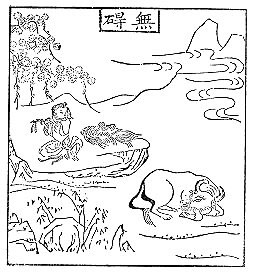
In the next pictures the boy and the ox are unconcerned about each other’s presence, there is no battle any more, there is no division; they exist in the same space because there is nothing to separate them; they are one and the same; this is a state of total harmony.
The next image is often described as ‘all forgotten’. The transition is virtually complete; nothing matters. The boys is there, the ox is there, but it is as if nothing is of consequence to either of them; it is just ‘being’.
The final images plunge deeply into the unknown and the esoteric, I don’t pretend to understand them, this is ‘returning to the origin’, whether you want to call this ‘the Great Tao’ or the ‘Universal Divine’ is up to you.
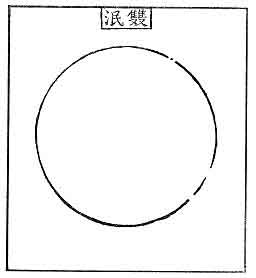
As an aside; many years ago, in my college education, myself and my fellow students were introduced to a retired educationalist, I wish I could remember his name. He was a very strange individual, very calm and patient, he spoke to us as if we were his children, but not in a condescending way. Here was a man who had lived a very full life (I think he’d been in the military during WW2). He encouraged us to ask searching questions, far beyond the limited educational brief. As the discussion opened out we found ourselves questioning the meaning of existence. He talked about ‘answers’ and I asked him, ‘what happens after you find all of the ‘answers?’ He paused slightly and then said, ‘You just… disappear’.
I remember, he smiled and just left that hanging in the air. If I am reading his reply correctly, this was the final message of the ox herding pictures. Here was the blank circle, or the empty landscape.
Leonard Cohen.
This set of pictures had a further reach than most of us realised.
I don’t know how many people are aware of this but singer songwriter Leonard Cohen had a soft spot for the ox herding narrative. I think it is common knowledge that Cohen plunged deeply into the Zen lifestyle, secluding himself in monastic Zen disciplines, indulging in harsh regimes of Zazen (seated meditation).
Some of his most thoughtful and erudite poetry and lyric writing came out of that experience. What ever you think of his vocal style and singing ability there is no getting away from the fact that Cohen was a talent that maybe even eclipsed Dylan. But people seemed not to have noticed a track called ‘The Ballad of the Absent Mare’ which featured on his 1979 album, ‘Recent Songs’.
Canadian singer songwriter Jennifer Warnes recounts how Cohen came over to her house after a meditational retreat, she said, “Leonard had found some old pictures somewhere, they were called ‘The Ten Bulls’, old Japanese woodcuts symbolizing the stages of a monk’s life on the road to enlightenment. These carvings pictured a boy and a bull, the boy losing the bull, the bull hiding, the boy realizing that the bull was nearby all along. There is a struggle, and finally the boy rides the bull into his little village. ‘I thought this would make a great cowboy song,’ he joked.” [2]
Here is a sample of Cohen’s ‘cowboy song’, obviously replace ‘mare’ with ‘ox’ and it’s the same tale:
“Say a prayer for the cowboy, his mare’s run away
And he’ll walk ’til he finds her, his darling, his stray
But the river’s in flood and the roads are awash
And the bridges break up in the panic of loss
And there’s nothing to follow, there’s nowhere to go
She’s gone like the summer, gone like the snow
And the crickets are breaking his heart with their song
As the day caves in and the night is all wrong
Did he dream, was it she who went galloping past?
And bent down the fern, broke open the grass
And printed the mud with the iron and the gold
That he nailed to her feet when he was the lord
And although she goes grazing a minute away
He tracks her all night, he tracks her all day
Oh, blind to her presence, except to compare
His injury here with her punishment there…”
Conclusion.
For this story/allegory to have been around for such a long time says something about its cultural power and its spiritual value. If you take any of the great or iconic stories that have stayed with humanity all the way from antiquity to the present day, their survival is an indication of what they have to teach us, as well as their resonance with the human condition; from the ‘Epic of Gilgamesh’ (2100 BCE) to ‘Moby Dick’, they present models and narratives that touch and inspire us.
The ox herd pictures could be seen as a compressed version of what Joseph Campbell refers to as the ‘Hero’s journey’ [3], but Campbell’s journey has 17 stages rather than 10. Campbell’s idea is so deeply engrained into western culture that we take it for granted; examples are: Homer’s ‘Odyssey’, ‘Star Wars’, ‘The Matrix’ and even ‘Harry Potter’.
The ox herd pictures are more overtly spiritual, but given their transcendent narrative there is much there to tie in to the martial artist’s personal odyssey, after all, martial arts also aspire to a transcendence, a development of character, a personal alchemy. Let us not pretend that our martial arts journey is devoid of spirituality; by that I don’t mean the ‘Spirituality’ that is allied to organised religion; but instead, the more secular brand, associated with pondering things that are outside and beyond yourself and your whole purpose of being alive and conscious and the meaning of your existence. Buddhism sought to address these puzzles without the need to resort to Gods or supernatural deities (although certain forms of Buddhism never quite shook off the shackles of shamanism, adding things that were never part of the original message).
Of course, martial arts people tend to be very pragmatic and deep meditation on spiritual matters are not to everyone’s taste. My thinking is that while I have no desire to become a Zen Buddhist there is something to gain from exploring the wider cultural context.
But that’s my view – to you, it might just be a load of old Bull.
For those of you have an inclination towards trivia; Cat Stevens’ 1972 studio album ‘Catch Bull at Four’ is an obvious reference, which may well have flown right over the head of the average pop music fan of the 1970’s. The album cover makes it very clear.
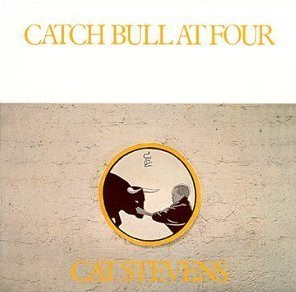
Tim Shaw
[1] Through personal research and correspondence with experts in the field, I have come to the opinion that works related to the Japanese martial arts that have been pegged as coming from the Zen tradition are actually Neo-Confucian in origin, e.g. Takuan Soho ‘The Unfettered Mind’.
[2] Source: https://www.songfacts.com/facts/leonard-cohen/ballad-of-the-absent-mare
[3] See Joseph Campbell’s ‘Hero with a Thousand Faces’. 1949.
If you are interested in the crossovers between far eastern traditions and philosophy and western psychology, I found that this book has some interesting sections relating to the Ox Herding Pictures; ‘Buddhism and Jungian Psychology’, J. Marvin Spiegelman and Mokusen Miyuki, 1994.
Other references and links:
https://en.wikipedia.org/wiki/Ten_Bulls
For an excellent description of the series follow this link: https://jessicadavidson.co.uk/2015/10/02/zen-ox-herding-pictures-introduction/
For the full lyrics by Leonard Cohen’s ‘The Ballad of the Absent Mare’ follow this link: https://www.azlyrics.com/lyrics/leonardcohen/balladoftheabsentmare.html
The image featured for ‘Catch Bull at Four’ is sourced from Wikipedia with the appropriate copyright stipulations cited here: https://upload.wikimedia.org/wikipedia/en/3/3d/Catch_Bull_at_Four.jpg
Ox herding pictures courtesy of: https://www.sacred-texts.com/bud/mzb/oxherd.htm